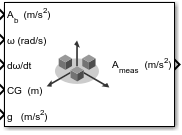Three-axis Accelerometer
Implement three-axis accelerometer
Libraries:
Aerospace Blockset /
GNC /
Navigation
Description
The Three-Axis Accelerometer block implements an accelerometer on each of the three axes. For more information on the ideal measured accelerations, see Algorithms.
Optionally, to apply discretizations to the Three-Axis Accelerometer block inputs and dynamics along with nonlinearizations of the measured accelerations, use the Saturation block.
The Three-axis Accelerometer block icon displays the input and output units selected from the Units parameter.
Limitations
Vibropendulous error and hysteresis effects are not accounted for in this block.
This block is not intended to model the internal dynamics of different forms of the instrument.
Ports
Input
Output
Parameters
Algorithms
The ideal measured accelerations () include the acceleration in body axes at the center of gravity () and lever arm effects due to the accelerometer not being at the center of gravity. Optionally, gravity in body axes can be removed. This is represented by the equation:
where are body-fixed angular rates, are body-fixed angular accelerations, and is the lever arm. The lever arm () is defined as the distances that the accelerometer group is forward, right, and below the center of gravity:
The orientation of the axes used to determine the location of the accelerometer group (xacc, yacc, zacc) and center of gravity (xCG, yCG, zCG) is from the zero datum (typically the nose) to aft, to the right of the vertical centerline and above the horizontal centerline. The x-axis and z-axis of these measurement axes are opposite the body-fixed axes that produce the negative signs in the lever arms for the x-axis and z-axis.
Measured accelerations () output by this block contain error sources and are defined as
where is a 3-by-3 matrix of scaling factors on the diagonal and misalignment terms in the nondiagonal, and are the biases.
References
[1] Rogers, R. M., Applied Mathematics in Integrated Navigation Systems, AIAA Education Series, 2000.
Extended Capabilities
Version History
Introduced before R2006a
